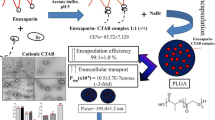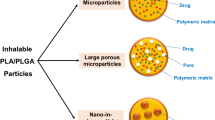Purpose
This study tests the hypothesis that complexation between a cationic polymer, poly-l-arginine (PLA), and an anionic drug, low molecular weight heparin (LMWH), enhances pulmonary absorption and reduces the epithelial toxicity.
Materials and Methods
Enoxaparin, a LMWH, was complexed with PLAs of different molecular weights at varying concentrations. The resulting complexes were characterized by measuring particle size and zeta potential, and by quantitating the interactions between PLA and enoxaparin using an azure A assay. Changes in transepithelial electrical resistance (TEER) and cytotoxicity induced by enoxaparin–PLA complex were investigated in Calu-3 cells. Pulmonary absorption of LMWH was determined by measuring plasma anti-factor Xa levels. A bronchoalveolar lavage (BAL) study was performed to investigate if the PLA-based formulations caused any cellular or biochemical changes in the lungs.
Results
The particle size of enoxaparin–PLA complexes decreased and the zeta potential values of the complex became less negative as the concentration of positively charged PLA in the complex increased. In vitro experiments suggest that addition of enoxaparin–PLA complex to the apical side of a polarized cell monolayer results in a significant increase in permeability to 14C-mannitol and a decrease in TEER. Pulmonary formulations of enoxaparin plus 0.0125% or 0.0625% PLA of molecular weight 93 kDa led to a twofold increase in the relative bioavailability of LMWH compared to the control (enoxaparin plus normal saline). The BAL study showed that the enoxaparin–PLA complex formulation did not elicit any significant increases in marker enzyme activities compared to the normal saline-treated or untreated control groups.
Conclusion
PLA could be used as a carrier for the pulmonary delivery of LMWH.






Similar content being viewed by others
References
H. Natsume, S. Iwata, K. Ohtake, M. Miyamato, M. Yamaguchi, K. Hosoya, D. Kobayashi, K. Sugibayashi, and Y. Morimoto. Screening of cationic compounds as an absorption enhancer for nasal drug delivery. Int. J. Pharm. 185:1–12 (1999).
M. Miyamoto, H. Natsume, S. Iwata, K. Ohtake, M. Yamaguchi, D. Kobayashi, K. Sugibayashi, M. Yamashina, and Y. Morimoto. Improved nasal absorption of drugs using poly-l-arginine: effects of concentration and molecular weight of poly-l-arginine on the nasal absorption of fluorescein isothiocyanate-dextran in rats. Eur. J. Pharm. Biopharm. 52:21–30 (2001).
N. M. Zaki, G. A. S. Awad, N. D. Mortada, and S. S. Abd ElHady. Rapid-onset intranasal delivery of metoclopramide hydrochloride Part I. Influence of formulation variables on drug absorption in anesthetized rats. Int. J. Pharm. 327:89–96 (2006).
M. Miyamoto, H. Natsume, I. Satoh, K. Ohtake, M. Yamaguchi, D. Kobayashi, K. Sugibayashi, and Y. Morimoto. Effect of poly-l-arginine on the nasal absorption of FITC-dextran of different molecular weights and recombinant human granulocyte colony-stimulating factor (rhG-CSF) in rats. Int. J. Pharm. 226:127–138 (2001).
N. M. Zaki, N. D. Mortada, G. A. S. Awad, and S. S. Abd ElHady. Rapid-onset intranasal delivery of metoclopramide hydrochloride Part II: Safety of various absorption enhancers and pharmacokinetic evaluation. Int. J. Pharm. 327:97–103(2006).
S. Deshayes, M. C. Morris, G. Divita, and F. Heitz. Cell-penetrating peptides: tools for intracellular delivery of therapeutics. Cell Mol. Life Sci. 62:1839–1849 (2005).
H. Matsui, K. Tomizawa, Y. F. Lu, and M. Matsushita. Protein Therapy: in vivo protein transduction by polyarginine (11R) PTD and subcellular targeting delivery. Curr. Protein Pept. Sci. 4:151–157 (2003).
K. Ohtake, T. Maeno, H. Ueda, H. Natsume, and Y. Morimoto. Poly-l-arginine predominantly increases the paracellular permeability of hydrophilic macromolecules across rabbit nasal epithelium in vitro. Pharm. Res. 20:153–160 (2003).
Y. Huang and M. D. Donovan. Large molecule and particulate uptake in the nasal cavity: the effect of size on nasal absorption. Adv. Drug Deliv. Rev. 29:147–155 (1998).
K. Yamada, M. Odomi, N. Okada, T. Fujita, and A. Yamamoto. Chitosan oligomers as potential and safe absorption enhancers for improving the pulmonary absorption of interferon-alpha in rats. J. Pharm. Sci. 94:2432–2440 (2005).
B. I. Florea, M. Thanou, H. E. Junginger, and G. Borchard. Enhancement of bronchial octreotide absorption by chitosan and N-trimethyl chitosan shows linear in vitro/in vivo correlation. J. Control. Release 110:353–361 (2006).
R. U. Agu, M. I. Ugwoke, M. Armand, R. Kinget, and N. Verbeke. The lung as a route for systemic delivery of therapeutic proteins and peptides. Respir. Res. 2:198–209 (2001).
J. Yu and Y. W. Chien. Pulmonary drug delivery: physiologic and mechanistic aspects. Crit. Rev. Ther. Drug Carrier Syst. 14:395–453 (1997).
F. Komada, S. Iwakawa, N. Yamamoto, H. Sakakibara, and K. Okumura. Intratracheal delivery of peptide and protein agents: absorption from solution and dry powder by rat lung. J. Pharm. Sci. 83:863–867 (1994).
D. C. Souza-Costa, T. Zerbini, I. F. Metzger, J. B. Rocha, R. F. Gerlach, and J. E. Tanus-Santos. l-Arginine attenuates acute pulmonary embolism-induced oxidative stress and pulmonary hypertension. Nitric Oxide 12:9–14 (2005).
S. J. Chu, T. Y. Lee, H. C. Yan, S. H. Lin, and M. H. Li. l-Arginine prevents air embolism-induced acute lung injury in rats. Crit. Care Med. 33:2056–2060 (2005).
R. D. Hull, G. E. Raskob, R. F. Brant, G. F. Pineo, G. Elliott, P. D. Stein, A. Gottschalk, K. A. Valentine, and A. F. Mah. Low molecular weight heparin vs heparin in the treatment of patients with pulmonary embolism. Arch. Intern. Med. 160:229–236 (2000).
S. Kaul and P. K. Shah. Low molecular weight heparin in acute coronary syndrome: Evidence for superior or equivalent efficacy compared with unfractionated heparin? J. Amer. Coll. Card. 35:1699–1712 (2000).
R. I. Shulman. Assessment of low-molecular-weight heparin trials in cardiology. Pharmaco. Ther. 87:1–9 (2000).
K. Salartash, M. D. Gonze, A. Leone-Bay, R. Baughman, C. Sternbergh III, and S. R. Money. Oral low-molecular weight heparin and delivery agent prevents jugular venous thrombosis in the rat. J. Vasc. Surg. 30:526–532 (1999).
J. J. Arnold, F. Ahsan, E. Meezan, and D. J. Pillion. Nasal administration of low molecular weight heparin. J. Pharm. Sci. 91:1707–1714 (2002).
T. Yang, F. Mustafa, and F. Ahsan. Alkanoylsucroses in nasal delivery of low molecular weight heparins: in-vivo absorption and reversibility studies in rats. J. Pharm. Pharmacol. 56:53–60 (2004).
M. Cadene, C. Boudier, G. D. de Marcillac, and J. G. Bieth. Influence of low molecular mass heparin on the kinetics of neutrophil elastase inhibition by mucus proteinase inhibitor. J. Biol. Chem. 270:13204–13209 (1995).
D. A. Scudiero, R. H. Shoemaker, K. D. Paull, A. Monks, S. Tierney, T. H. Nofziger, M. J. Currens, D. Seniff, and M. R. Boyd. Evaluation of a soluble tetrazolium/formazan assay for cell growth and drug sensitivity in culture using human and other tumor cell lines. Cancer Res. 48:4827–4833 (1988).
T. Yang, F. Mustafa, S. Bai, and F. Ahsan. Pulmonary delivery of low molecular weight heparins. Pharm. Res. 21:2009–2016 (2004).
A. Hussain and F. Ahsan. State of insulin self-association does not affect its absorption from the pulmonary route. Eur. J. Pharm. Sci. 25:289–298 (2005).
P. R. Dash, M. L. Read, L. B. Barrett, M. A. Wolfert, and L. W. Seymour. Factors affecting blood clearance and in vivo distribution of polyelectrolyte complexes for gene delivery. Gene Ther. 6:643–650 (1999).
H-M. Buchhammer, M. Mende, and M. Oelmann. Formation of mono-sized polyelectrolyte complex dispersions: effects of polymer structure, concentration and mixing conditions. Colloids and Surfaces A: Physicochem. Eng. Aspects 218:151–159 (2003).
K. Tadano-Aritomi and I. Ishizuka. Determination of peracetylated sulfoglycolipids using the azure A method. J. Lipid Res. 24:1368–1375 (1983).
S. R. Gundry, M. D. Klein, R. A. Drongowski, and M. M. Kirsh. Clinical evaluation of a new rapid heparin assay using the dye azure A. Am. J. Surg. 148:191–194 (1984).
T. Yang, A. Hussain, S. Bai, I.A. Khalil, H. Harashima, and F. Ahsan. Positively charged polyethylenimines enhance nasal absorption of the negatively charged drug, low molecular weight heparin. J. Control. Release 115:289–297 (2006).
K. A. Foster, M. L. Avery, M. Yazdanian, and K. L. Audus. Characterization of the Calu-3 cell line as a tool to screen pulmonary drug delivery. Int. J. Pharm. 208:1–11 (2000).
N. R. Mathia, J. Timoszyk, P. I. Stetsko, J. R. Megill, R. L. Smith, and D. A. Wall. Permeability characteristics of calu-3 human bronchial epithelial cells: in vitro–in vivo correlation to predict lung absorption in rats. J. Drug Target. 10:31–40 (2002).
B. Forbes. Human airway epithelial cell lines for in vitro drug transport and metabolism studies. Pharm. Sci. Tech. Today 3:18–27 (2000).
G. Wang, J. Zabner, C. Deering, J. Launspach, J. Shao, M. Bodner, D. J. Jolly, B. L. Davidson, and P. B. McCray. Increasing epithelial junction permeability enhances gene transfer to airway epithelia in vivo. Am. J. Respir. Cell Mol. Biol. 22:129–138 (2000).
P. Bianchini, G. L. Bergonzini, B. Parma, and B. N. Osima. Relationship between plasma anti-factor Xa activity and the antithrombotic activity of heparins of different molecular mass. Homeostasis 25:288–298 (1995).
D. C. Litzinger, A. M. Buiting, N. van Rooijen, and L. Huang. Effect of liposome size on the circulation time and intraorgan distribution of amphipathic poly(ethylene glycol)-containing liposomes. Biochim. Biophys. Acta 1190:99–107 (1994).
D. A. Uchida, C. G. Irvin, C. Ballowe, G. Larsen, and G. R. Cott. Cationic proteins increase the permeability of cultured rabbit tracheal epithelial cells: modification by heparin and extracellular calcium. Exp. Lung Res. 22:85–99 (1996).
M. Hammes and A. Singh. Effect of polycations on permeability of glomerular epithelial cell monolayers to albumin. J. Lab. Clin. Med. 123:437–446 (1994).
L. Illum, N. F. Farraj, and S. S. Davis. Chitosan as a novel delivery system for peptide drugs. Pharm. Res. 11:1186–1189 (1994).
G. T. McEwan, M. A. Jepson, B. H. Hirst, and N. L. Simmons. Polycation-induced enhancement of epithelial paracellular permeability is independent of tight junctional characteristics. Biochim. Biophys. Acta 1148:51–60 (1993).
N. G. Schipper, S. Olsson, J. A. Hoogstraate, A. G. deBoer, K. M. Varum, and P. Artursson. Chitosan as absorption enhancers for poorly absorbable drugs 2: mechanism of absorption enhancement. Pharm. Res. 14:923–929 (1997).
J. Wang, S. Sakai, Y. Deguchi, D. Bi, Y. Tabata, and K. Morimoto. Aminated gelatin as a nasal absorption enhancer for peptide drugs: evaluation of absorption enhancing effect and nasal mucosa perturbation in rats. J. Pharm. Pharmacol. 54:181–188 (2002).
A. C. Hunter. Molecular hurdles in polyfectin design and mechanistic background to polycation induced cytotoxicity. Adv. Drug Deliv. Rev. 58:1523–1531 (2006).
S. Shahana, C. Kampf, and G. M. Roomans. Effect of the cationic protein poly-l-arginine on airway epithelial cells in vitro. Mediators Inflamm. 11:141–148 (2002).
D. Fischer, T. Bieber, Y. Li, H. P. Elsasser, and T. Kissel. A novel non-viral vector for DNA delivery based on low molecular weight, branched polyethylenimine: effect of molecular weight on transfection efficiency and cytotoxicity. Pharm. Res. 16:1273–1279 (1999).
R. F. Henderson, J. M. Benson, F. F. Hahn, C. H. Hobbs, R. K. Jones, J. L. Muaderly, R. O. McClellan, and J. A. Pickrell. New approaches for the evaluation of pulmonary toxicity: bronchoalveolar lavage fluid analysis. Fund. Appl. Toxicol. 5:451–458 (1985).
D. B. DeNicola, A. H. Rebar, and R. F. Henderson. Early damage indications in the lung. V. Biochemical and cytological response to NO2 inhalation. Toxicol. Appl. Pharmacol. 60:301–312 (1981).
A. J. Hickey and L. Garcia-Contreras. Immunological and toxicological implication of short-term studies in animals of pharmaceutical aerosol delivery to the lungs: relevance to humans. Crit. Rev. Ther. Drug Carrier Syst. 18:387–431 (2001).
Acknowledgments
This work was supported in part by an NIH grant R15 HL7713301 (FA).
Author information
Authors and Affiliations
Corresponding author
Additional information
Amit Rawat and Tianzhi Yang had an equal contribution to the manuscript.
Rights and permissions
About this article
Cite this article
Rawat, A., Yang, T., Hussain, A. et al. Complexation of a Poly-l-Arginine with Low Molecular Weight Heparin Enhances Pulmonary Absorption of the Drug. Pharm Res 25, 936–948 (2008). https://doi.org/10.1007/s11095-007-9442-x
Received:
Accepted:
Published:
Issue Date:
DOI: https://doi.org/10.1007/s11095-007-9442-x




